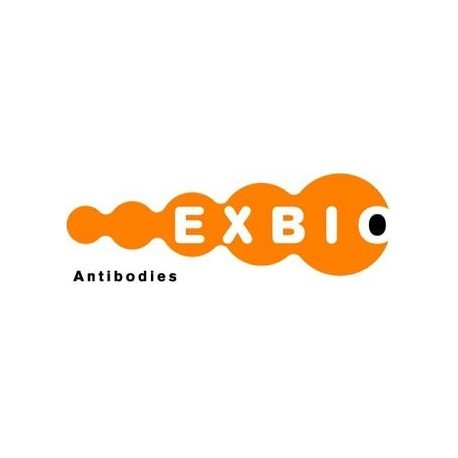Cart 0 Product Products (empty)
No products
To be determined Shipping
0,00 € Total
Prices are tax excluded
Product successfully added to your shopping cart
Quantity
Total
There are 0 items in your cart. There is 1 item in your cart.
Total products (tax excl.)
Total shipping (tax excl.) To be determined
Total (tax excl.)
Data sheet of Mouse Monoclonal to CD161 (rat)
| Brand | Exbio |
| Product type | Primary antibodies |
| Reactivity | Rat |
| Clonality | Monoclonal |
More info about Mouse Monoclonal to CD161 (rat)
| Brand: | Exbio |
| Product no.: | 11-657-C100 |
| Product type: | Primary antibodies |
| Host species: | Mouse |
| Product name: | Mouse Monoclonal to CD161 (rat) |
| Antigen: | CD161 (rat) |
| Clonality: | Monoclonal |
| Clone: | 10/78 |
| Isotype: | IgG1 |
| Immunogen: | Splenic cells purified from the LEW rat |
| Format: | purified |
| Specificity: | The mouse monoclonal antibody 10/78 recognizes CD161, an approximately 30 kDa type II transmembrane C-type lectin receptor, expressed on the plasma membrane of NK cells, dendritic cells, activated monocytes and a subset of T cells as a disulphide-linked homodimer. A common epitope on rat CD161a and b isoforms is detected. |
| Categories: | CD and Related Antigens & MHC (Rodent) |
| Concentration: | 1 mg/ml |
| Storage buffer: | Phosphate buffered saline (PBS) with 15 mM sodium azide, approx. pH 7.4 |
| Storage / stability: | Store at 2-8°C. Do not freeze. Do not use after expiration date stamped on vial label. |
| Background: | CD161, also known as Nkrp1 (natural killer receptor protein 1) or Klrb1 (killer cell lectin-like receptor subfamily b member 1), is a disulphide-linked homodimeric receptor, which is involved in regulation of NK cell and NKT cell function. It is expressed on rat NK cells, subset of T cells, dendritic cells, and activated monocytes. Although human CD161 is expressed as one isoform, the rat CD161 has three isoforms, referred to as CD161a, b, and c. These proteins contain C-terminal C-type lectin extracellular domain, a transmembrane domain, and N-terminal intracellular domain, which contains ITIM motif, such as CD161b, and displays inhibitory function, or does not contain ITIM motif, thus also not the inhibitory function, such as CD161a. |
| Purity: | > 95% (by SDS-PAGE) |
| Purification: | Purified by protein-A affinity chromatography |
| Product specific references: | *Kraus E, Lambracht D, Wonigeit K, Hünig T: Negative regulation of rat natural killer cell activity by major_x000D_ histocompatibility complex class I recognition. Eur J Immunol. 1996 Nov;26(11):2582-6., *Sedgwick JD, Ford AL, Foulcher E, Airriess R: Central nervous system microglial cell activation and proliferation follows_x000D_ direct interaction with tissue-infiltrating T cell blasts. J Immunol. 1998 Jun 1;160(11):5320-30., *Tliba O, Chauvin A, Le Vern Y, Boulard C, Sbille P: Evaluation of the hepatic NK cell response during the early phase of Fasciola hepatica infection in rats. Vet Res. 2002 May-Jun;33(3):327-32., *Teshima R, Nakamura R, Nakamura R, Hachisuka A, Sawada JI, Shibutani M: Effects of exposure to decabromodiphenyl ether on the development of the immune system in rats. J Health Sci 2008;54(4):382-389, *Chang CJ, Tai KF, Roffler S, Hwang LH: The immunization site of cytokine-secreting tumor cell vaccines influences the_x000D_ trafficking of tumor-specific T lymphocytes and antitumor efficacy against regional tumors. J Immunol. 2004 Nov 15;173(10):6025-32., *Stephens LA, Barclay AN, Mason D: Phenotypic characterization of regulatory CD4+CD25+ T cells in rats. Int Immunol. 2004 Feb;16(2):365-75., *May E, Dorris ML, Satumtira N, Iqbal I, Rehman MI, Lightfoot E, Taurog JD: CD8 alpha beta T cells are not essential to the pathogenesis of arthritis or colitis in HLA-B27 transgenic rats. J Immunol. 2003 Jan 15;170(2):1099-105. |
| Related products: | - Mouse Monoclonal to CD164 - Mouse Monoclonal to CD162 / PSGL-1 - Mouse Monoclonal to CD163 |
| Shipping condition: | Room temperature |


